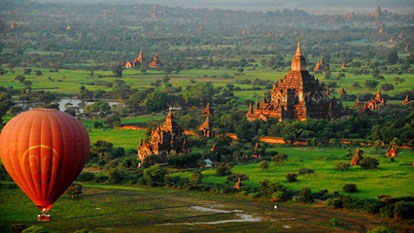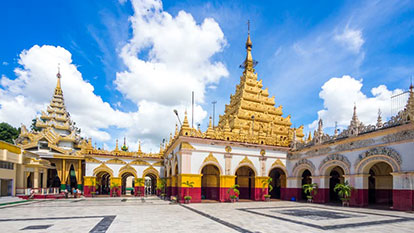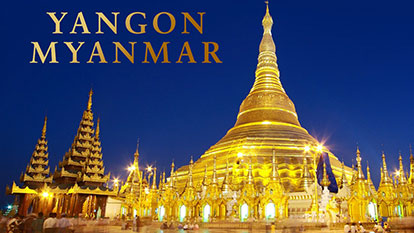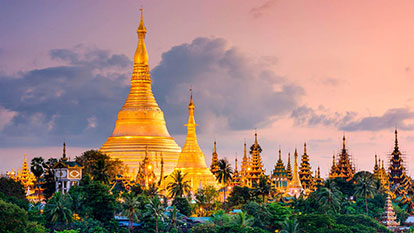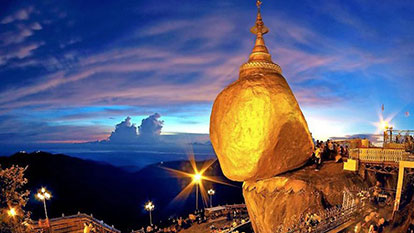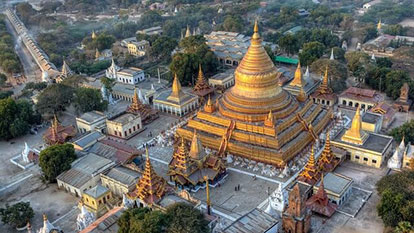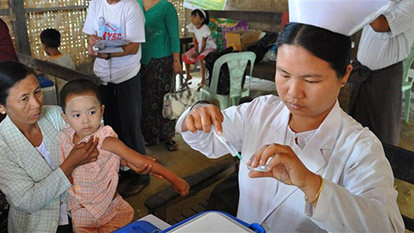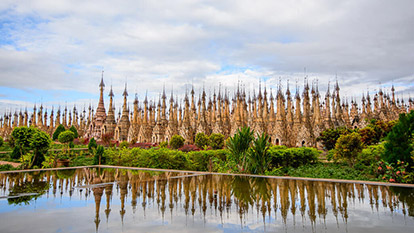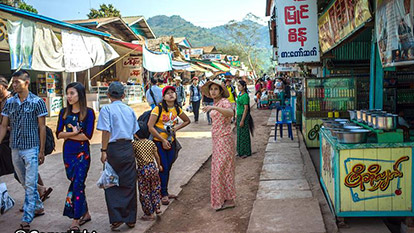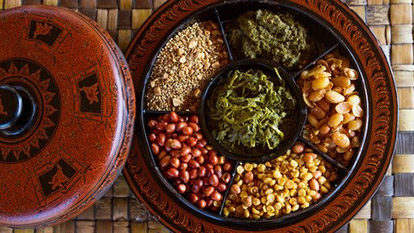Myanmar History
13/04/2019 926 Views
Known as Burma while under British colonial rule, and still referred to as such by the UK and US governments as well as many pro-democracy campaigners, the area now known as Myanmar was populated through three waves of migration: by the Hmon people from what is now Cambodia; by Mongol people from the eastern Himalayas; and, finally, by Thais from northern Thailand.
Starting in 1824, the British, driven by imperial ambitions and goaded by repeated border clashes, began the process of annexing Burma as part of British India. During WWII, the Japanese expelled the British from Burma and attempted to co-opt Burmese political support by offering nominal independence. General Aung San, who had originally sided with the Japanese, led an uprising against them and went on to guide the country to independence in 1948. He was assassinated the same year by men believed to have been working for a political rival.
A military coup in 1962 brought to power Ne Win, who renamed the country the Socialist Republic of the Union of Burma and imposed a totalitarian dictatorship. In 1988, after years of bizarre policies, isolationism and chronic economic mismanagement, a popular uprising began with students and Buddhist monks to the fore. It reached its peak with a general strike starting on 8 August, but the military stepped in and brutally suppressed the demonstrations. Although Ne Win relinquished his official title as leader of the nation, he continued to exercise considerable influence. Ex-army General Tin Oo and the Western-educated liberal Aung Sang Suu Kyi, daughter of Aung San, led the principal internal opposition.
After crushing domestic political opposition, the Ne Win junta – which had turned away from socialism – announced in 1989 that elections would be held. The main opposition movements campaigned under the banner of the National League for Democracy (NLD), led by Aung San Suu Kyi who had been placed under house arrest, and won the 1990 election. The regime held onto power, however, and Suu Kyi remained under house arrest until 1995.
During the early 1990s, the regime had become an international pariah. In 2000, Aung San Suu Kyi was once again put under house arrest and would remain that way for almost all of the next decade. The country’s turmoils continued with the 2007 Saffron Revolution, which began in response to massive increases in fuel prices. Monks and civilians were beaten, killed or arrested during the anti-government protests.
After general elections which were boycotted by the NLD, March 2011 saw Thein Sein of the Union Solidarity and Development Party elected as President of Myanmar. Although nominally civilian, the government remained under the sway of the military (which is guaranteed a quarter of parliamentary seats) and cronyism remained endemic. And although it reached peace deals with some ethnic minority militias, in parts of the country the government continued what has been described as the world’s longest-running civil war. The military continues to be implicated in atrocities against civilians.
Nevertheless, the UN and governments including those of the US and UK praised Thein Sein for his reforms which included releasing some political prisoners, amongst them Aung San Suu Kyi who was released in 2010. In 2012 many of the international sanctions against Myanmar were dropped, but the same year Myanmar also made headlines as violence broke out in Rakhine State – directed against a Muslim minority (the Rohingya) by the Buddhist majority. In 2013 similar religiously-motivated riots occurred in the town of Meiktila. The NLD has been criticised internationally for failing to condemn the violence, and also for starting to work more closely with the government and the military.
The next major political milestone for the country will come with the general elections in 2015. As things stand, Aung San Suu Kyi is ineligible to run for president because she married a foreigner, although there are hopes that the constitution will be changed.
A military coup in 1962 brought to power Ne Win, who renamed the country the Socialist Republic of the Union of Burma and imposed a totalitarian dictatorship. In 1988, after years of bizarre policies, isolationism and chronic economic mismanagement, a popular uprising began with students and Buddhist monks to the fore. It reached its peak with a general strike starting on 8 August, but the military stepped in and brutally suppressed the demonstrations. Although Ne Win relinquished his official title as leader of the nation, he continued to exercise considerable influence. Ex-army General Tin Oo and the Western-educated liberal Aung Sang Suu Kyi, daughter of Aung San, led the principal internal opposition.
After crushing domestic political opposition, the Ne Win junta – which had turned away from socialism – announced in 1989 that elections would be held. The main opposition movements campaigned under the banner of the National League for Democracy (NLD), led by Aung San Suu Kyi who had been placed under house arrest, and won the 1990 election. The regime held onto power, however, and Suu Kyi remained under house arrest until 1995.
During the early 1990s, the regime had become an international pariah. In 2000, Aung San Suu Kyi was once again put under house arrest and would remain that way for almost all of the next decade. The country’s turmoils continued with the 2007 Saffron Revolution, which began in response to massive increases in fuel prices. Monks and civilians were beaten, killed or arrested during the anti-government protests.
After general elections which were boycotted by the NLD, March 2011 saw Thein Sein of the Union Solidarity and Development Party elected as President of Myanmar. Although nominally civilian, the government remained under the sway of the military (which is guaranteed a quarter of parliamentary seats) and cronyism remained endemic. And although it reached peace deals with some ethnic minority militias, in parts of the country the government continued what has been described as the world’s longest-running civil war. The military continues to be implicated in atrocities against civilians.
Nevertheless, the UN and governments including those of the US and UK praised Thein Sein for his reforms which included releasing some political prisoners, amongst them Aung San Suu Kyi who was released in 2010. In 2012 many of the international sanctions against Myanmar were dropped, but the same year Myanmar also made headlines as violence broke out in Rakhine State – directed against a Muslim minority (the Rohingya) by the Buddhist majority. In 2013 similar religiously-motivated riots occurred in the town of Meiktila. The NLD has been criticised internationally for failing to condemn the violence, and also for starting to work more closely with the government and the military.
The next major political milestone for the country will come with the general elections in 2015. As things stand, Aung San Suu Kyi is ineligible to run for president because she married a foreigner, although there are hopes that the constitution will be changed.
ONLY WITH US : 100 % MONEY BACK GUARANTEE within 10 days from the date of booking if not satisfied.
For further information, or simply a free quote, please contact us at any time via our email: info@galatourist.com, our experienced consultants will reply to you within 48 hours.Sincerely yours & see you soon!
GALATOURIST since 2005.
Related Articles
Explore the Bago fairy city, south of Yangon - Myanmar
If you have visited all the beautiful scenery in Yangon and have no plans to go. So wait, come to the city of Bago right and always !
Top 5 ancient Buddhist temples in Bagan, Myanmar
Anyone who has the passion to explore the mystical beauty of Myanmar when arriving in Bagan can’t fail to visit the monuments of ancient monuments left here. The Buddhist temples that stand along the flow of time are the testimony to the dynasties and Buddhist culture in Myanmar.
The famous tourist destinations of Mandalay, Myanmar
Mandalay is the principal economic and religious city of upper Myanmar. It is situated in the centre of the country and 714 km north of Yangon. It was founded in 1857 by King Mindon, where the Royal Palace of the Konbaung Dynasty is located and it was the last monarchy until being occupied by the British in 1885. Today, Mandalay is still accepted as the art and cultural heartland of Myanmar and one can also discover the history, tradition, ritual and ceremonies there. Moreover, it is also easily accessible to Sagaing, Ava (Inwa), Amarapura, Mingun and Pyin Oo Lwin.
Attractive and impressive experiences in Yangon, Myanmar
Yangon is one of famous places in Myanmar, where well-known tourist attractions, tourist services are diverse and attractive. If you want to enjoy adventure travel in Yangon Myanmar, you should read the post carefully to known about wonderful experiences in there.
The Shwedagon Pagoda in Yangon
The Shwedagon Pagoda is one of the most famous pagodas in the world and it is certainly the main attraction of Yangon, Myanmar’s capital city.
The Golden Rock - Kyaiktiyo
The Golden Rock (Kyaik-htiyo or Kyaiktiyo), perched atop a cliff near Yangon, is one of the most sacred sites in Burma. The great boulder precariously balances on the edge of a cliff and is topped by a small stupa. An endless stream of pilgrims come to admire the sight and add squares of gold leaf to its surface.
The Shwezigon Pagoda of Bagan
Gold plated pagoda built by the founder of the Bagan empire. The Shwezigon Pagoda is one of the oldest and most impressive monuments of Bagan. Most noticeable is the huge gold plated pagoda glimmering in the sun. The design of the Shwezigon Pagoda has been copied many times across Burma over the centuries.
Myanmar Currency & Money
Riel (KHR; symbol CR) is the country’s official currency but locals prefer to use dollars. Riel notes are in denominations of CR100,000, 50,000, 20,000, 10,000, 5,000, 2,000, 1,000, 500, 200, 100 and 50. Dollars notes (not coins) are widely accepted, yet visitors in small villages and shops vendors may not have change for high notes (including $10+). It is advisable to keep hold of small Riel change wherever you can as it is very useful.
Myanmar Health Care and Vaccinations
There are hospitals and clinics in cities and larger towns, and regional health centres in outlying areas, although the quality of healthcare is generally low in Myanmar. Many hospitals lack basic equipment and medication, a situation not helped by high levels of corruption, and international-standard facilities
Things to see and do in Myanmar
The small town of Hpa-an, in the southeast of the country, is a pleasant place to spend a few days. Moreover there are some excellent day trips from the town, and you can take a taxi or ride a rented motorbike through scenic rice fields to swimming holes, a pagoda perched on a vertical column of rock, and caves full of Buddhist art.
Myanmar Shopping and nightlife
Myanmar’s cities are not shopping destinations on a par with regional favourites such as Bangkok or Singapore, but there are still some bargains to be found. Souvenirs include jewellery – some of the most interesting being made from petrified wood or from jade
Myanmar Food and Drink
The regional cuisine balances spicy, sour, bitter and salty flavours; it can be quite hot but rarely as much so as Thai food. Common local ingredients include fish, seafood, chicken and vegetables spiced with onions, ginger, garlic and chillies, served with rice or noodles
Testimonials
The following are the real customer reviews about GalaTourist by video clips, email & feedback form, etc... please check it out!

Ms. Francesca Tronconi & Mr Vizzolini Davide (2pax) from Spain
Ms. Francesca Tronconi & Mr Vizzolini Davide from Spain, taked a Tour in Vietnam on 8.2018

Mrs & Mr. DUPUIS (2pax) from United States
Mrs & Mr. DUPUIS from US taked a vacation of THAILAND & CAMBODIA & VIETNAM 14 days on 3.2018

Mr. Jeffrey Szymanski (2pax) from United States
They taked a trip of Vietnam and Cambodia 11 days on 3.2018

Mrs Rosemary McGuinness (2pax) from Australia
Taking a trip of Vietnam & Cambodia 14 days on 26th mars 2018

Mrs Elena Maria Sanchez (2pax) from Spain
Mrs Elena Maria Sanchez from Spain taked a trip in Vietnam on 1.2016

Group Marissa (4pax) from United States
Group Marissa 4pax from USA taked a Trip in Vietnam on 2.2016

Mr Jerzy (2pax) from Canada
Mr Jerzy from Canada have traveled in Vietnam on 3.2016

Mr Ricardo Velasco (8pax) from Argentina
Sr Ricardo Velasco 8pax - Argentina taked a trip to Vietnam Cambodia Thailand on 2016.





